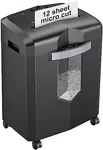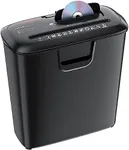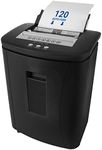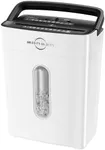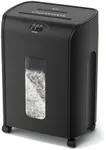Buying Guide for the Best Office Shredders
Choosing the right office shredder is essential for maintaining the security and confidentiality of your documents. When selecting a shredder, consider the volume of documents you need to shred, the sensitivity of the information, and the frequency of use. Understanding the key specifications will help you make an informed decision that best suits your office needs.Shred TypeShred type refers to the way the shredder cuts the paper. There are three main types: strip-cut, cross-cut, and micro-cut. Strip-cut shredders cut paper into long, narrow strips and are suitable for less sensitive documents. Cross-cut shredders cut paper into small pieces, providing a higher level of security and are ideal for confidential documents. Micro-cut shredders offer the highest level of security by cutting paper into tiny particles, making them perfect for highly sensitive information. Choose the shred type based on the level of security you need.
Sheet CapacitySheet capacity indicates the number of sheets a shredder can handle at once. This is important for efficiency and convenience. Shredders with a lower sheet capacity (5-10 sheets) are suitable for small offices or personal use. Medium capacity shredders (10-20 sheets) are ideal for moderate use in small to medium-sized offices. High capacity shredders (20+ sheets) are designed for heavy use in larger offices. Consider the volume of documents you need to shred regularly to determine the appropriate sheet capacity.
Run Time and Cool Down TimeRun time is the duration a shredder can operate continuously before needing to cool down. Cool down time is the period the shredder needs to rest before it can be used again. Shredders with short run times (2-5 minutes) and longer cool down times (20-40 minutes) are suitable for occasional use. Shredders with longer run times (10-30 minutes) and shorter cool down times (10-20 minutes) are better for frequent use. Continuous run time shredders can operate without needing to cool down and are ideal for high-volume shredding. Choose based on how often and how long you need to use the shredder.
Bin CapacityBin capacity refers to the amount of shredded paper the shredder can hold. This is important for determining how often you need to empty the bin. Small bin capacities (1-5 gallons) are suitable for personal or low-volume use. Medium bin capacities (5-10 gallons) are ideal for small to medium-sized offices. Large bin capacities (10+ gallons) are designed for high-volume use in larger offices. Consider the volume of shredding and how often you want to empty the bin to choose the right capacity.
Noise LevelNoise level is the amount of sound the shredder produces while operating. This is important for maintaining a quiet and comfortable office environment. Shredders with lower noise levels (below 60 decibels) are ideal for shared or open office spaces. Shredders with moderate noise levels (60-70 decibels) are suitable for private offices or areas where noise is less of a concern. Higher noise levels (above 70 decibels) may be acceptable in environments where noise is not an issue. Consider the office setting and the importance of noise reduction when choosing a shredder.
Safety FeaturesSafety features are designed to prevent accidents and ensure safe operation. Common safety features include automatic shut-off, which stops the shredder when hands or objects are too close, and safety locks, which prevent unauthorized use. Some shredders also have sensors that detect paper jams and reverse the shredding process. These features are particularly important in environments with multiple users or where safety is a priority. Choose a shredder with the necessary safety features to ensure safe and secure operation.




